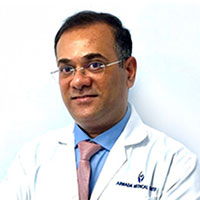- Home
- >
- Temporomandibular Disorders – Demystifying...
Temporomandibular Disorders – Demystifying the Myths
Dentistry
August 30, 2022 - 16:00 - 17:00 (UAE time)
Topic Description :
Temporomandibular Disorders – Demystifying the Myths
Abstract:
TMDs encompass a group of musculoskeletal conditions involving TMJs, masticatory muscles and associated tissues. Pain from the TMJ can emanate from either the osseous tissues themselves of from the associated soft tissues. For an effective therapy, accurate identification of the pain source is the key. Clinicians should show their diligence in making an accurate diagnosis and accordingly manage TMDs using principle of evidence-based management and using the most conservative and least invasive approach.
Introduction:
TMDs encompass a group of painful and nonpainful musculoskeletal condition that involve the TMJs, the masticatory muscles and contiguous tissues components. TMDs are the major cause of nondental pain in the Orofacial region. Two common types of painful TMDs are (i) Myogenous or muscle generated pain & (ii) Arthrogenous or joint generated pain. The etiology of TMDs is multifactorial and many TMJ disorders may be primarily due to overuse or overloading of the system. Pain is the most frequent presenting symptom usually localized in the muscle of mastication of the preauricular area. Adopting a conservative treatment approach with an aim towards reducing inflammation, encouraging healing & repair by reducing loading, and restoring function are the keys to success for most patients.
Learning Objectives:
- Etiology of TMDs is multifactorial and there is no single cause for all TMDs.
- Parafunctional oral habits are a contributing factors and management of TMDs should include control of such contributing factors.
- Pain-free TMJ clicking generally does not need any treatment other than the reassurance and educating the patient about this benign condition.
- Most patients with TMDs achieve good relief from the symptoms using conservative therapy alone.
- Management of TMDs should include patient education, self-management instruction, oral appliances, pharmacotherapy, physical therapy and Cognitive behaviour therapy.
- Occlusal adjustment is an irreversible and invasive treatment modality and should not be considered as initial therapy for TMD.
- Invasive surgical management is indicated only when all above non-surgical methods have failed and when the TMD symptoms significantly affect patient’s quality of life.
Speaker :

Dr. Sumit G Gupta
BDS, MDS ( Orthodontics)
Diplomate, American Board of Orofacial Pain
Director
RAK Dental Care & Implant Centre – Ras Al Khaimah
UAE
Bio:
Dr. Sumit Gupta, is a Specialist Orthodontist in Armada Medical Centre, Dubai. a Diplomate of the American Board of Orofacial Pain, Fellow – Temperomandibular Disorders, Orofacial Pain and Dental Sleep Medicine and did mastership from Roseman University, School of Dental Medicine, USA. He is a Certified Invisalign Provider and Incognito Certified Lingual Orthodontist. He is practicing in UAE for the past 24 years. Dr. Gupta is a DOH, DHA & MOH licensed Specialist Orthodontist.
Accredited by
INDEX Conferences & Exhibitions Organisation Est is an ADA CERP Recognized Provider. ADA CERP is a service of the American Dental Association to assist dental professionals in identifying quality providers of continuing dental education. ADA CERP does not approve or endorse individual courses or instructors, nor does it imply acceptance of credit hours by boards of dentistry. INDEX Conferences & Exhibitions Organisation Est. designates this activity for 1 continuing education credits.

The International Congress For Health Specialties – ICHS certifies that the Waterfalls Initiative for Continuous Education who are organizing the Temporomandibular Disorders – Demystifying the Myths Webinar adopting an online learning format on August 30, 2022 shall be awarded 1 ICHS CME Credits
Organised By

